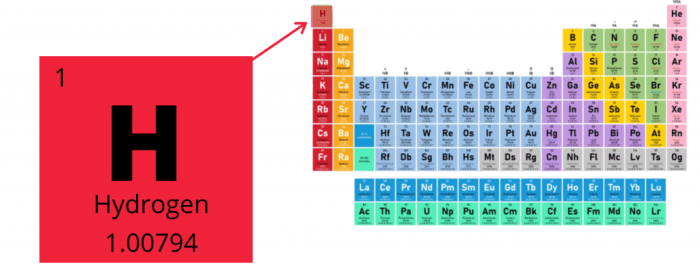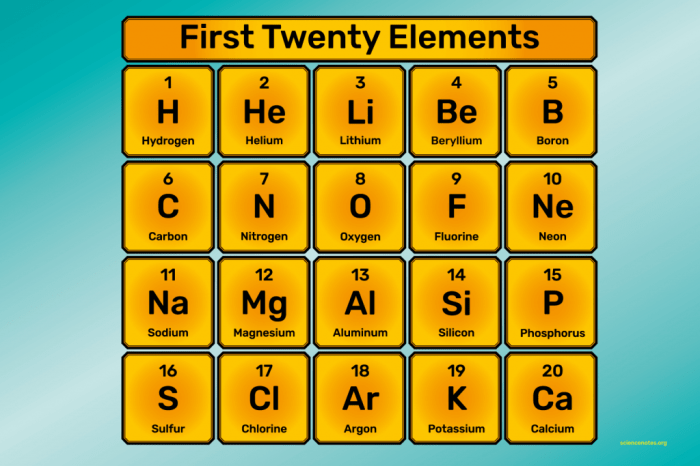Embarking on an exploration of the first 18 elements on the periodic table, we delve into a captivating narrative that unravels the fundamental building blocks of our universe. From their humble beginnings to their profound impact on modern science and technology, these elements hold a wealth of knowledge and intrigue that will captivate the minds of inquisitive readers.
As we journey through the periodic table, we will encounter elements that have shaped the course of human history, from the fiery brilliance of hydrogen to the enigmatic allure of the noble gases. Their unique properties and intricate interactions have enabled countless innovations, from the electronics that connect us to the medicines that heal us.
History of the First 18 Elements

The discovery and isolation of the first 18 elements on the periodic table marked a significant chapter in the history of chemistry. These elements, ranging from hydrogen to argon, laid the foundation for our understanding of the structure and behavior of matter.
The first major breakthrough in this field came in the 17th century with the work of Robert Boyle, who proposed the idea that matter is composed of indivisible particles called atoms. This concept laid the groundwork for the development of the atomic theory by John Dalton in the early 19th century.
In the following decades, scientists such as Antoine Lavoisier, Joseph Priestley, and Henry Cavendish made important discoveries that furthered our understanding of elements and their properties. Lavoisier’s experiments on combustion and respiration led to the discovery of oxygen, while Priestley isolated several gases, including oxygen, nitrogen, and hydrogen chloride.
Physical and Chemical Properties of the First 18 Elements

| Element | Atomic Number | Atomic Mass | Melting Point (°C) | Boiling Point (°C) | Density (g/cm3) |
|---|---|---|---|---|---|
| Hydrogen | 1 | 1.008 | -259.2 | -252.9 | 0.0899 |
| Helium | 2 | 4.0026 | -272.2 | -268.9 | 0.1786 |
| Lithium | 3 | 6.941 | 179 | 1342 | 0.534 |
| Beryllium | 4 | 9.0122 | 1287 | 2472 | 1.85 |
| Boron | 5 | 10.811 | 2076 | 3927 | 2.34 |
| Carbon | 6 | 12.011 | 3550 | 4827 | 2.26 |
| Nitrogen | 7 | 14.007 | -210 | -196 | 1.251 |
| Oxygen | 8 | 15.999 | -218.4 | -183 | 1.429 |
| Fluorine | 9 | 18.998 | -220 | -188 | 1.696 |
| Neon | 10 | 20.180 | -248.6 | -246.1 | 0.9002 |
| Sodium | 11 | 22.990 | 97.6 | 892 | 0.971 |
| Magnesium | 12 | 24.305 | 650 | 1090 | 1.738 |
| Aluminum | 13 | 26.982 | 660.3 | 2519 | 2.70 |
| Silicon | 14 | 28.085 | 1414 | 2355 | 2.33 |
| Phosphorus | 15 | 30.974 | 44.1 | 280 | 1.82 |
| Sulfur | 16 | 32.066 | 113 | 444.6 | 2.07 |
| Chlorine | 17 | 35.453 | -101 | -34.6 | 3.214 |
| Argon | 18 | 39.948 | -189.4 | -185.9 | 1.784 |
As we move across the periodic table from left to right, the elements generally exhibit an increase in atomic number, atomic mass, melting point, boiling point, and density. This trend can be attributed to the gradual increase in the number of protons, neutrons, and electrons in the atoms.
In terms of chemical properties, the first 18 elements show a wide range of reactivity. Hydrogen and the noble gases are relatively unreactive, while the alkali metals (Group 1) and halogens (Group 17) are highly reactive. These differences in reactivity can be explained by the electronic configurations of the elements.
FAQ Compilation: The First 18 Elements On The Periodic Table
What is the significance of the first 18 elements on the periodic table?
The first 18 elements on the periodic table are the foundation of chemistry, as they represent the simplest and most fundamental building blocks of matter. These elements play a crucial role in countless chemical reactions and processes, forming the basis for all known substances in the universe.
How were the first 18 elements discovered?
The discovery of the first 18 elements spanned centuries, with each element being isolated through a unique combination of experimentation and scientific ingenuity. Notable scientists involved in these discoveries include Antoine Lavoisier, Humphry Davy, and Dmitri Mendeleev, among others.
What are some interesting applications of the first 18 elements?
The first 18 elements find applications in a vast array of fields, including electronics, medicine, and construction. Hydrogen is used in fuel cells and rocket propellants, oxygen is essential for life and medical procedures, and iron is a vital component in steel and other alloys.

